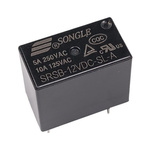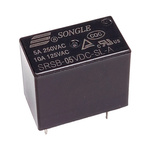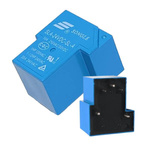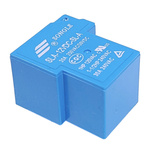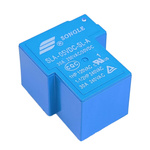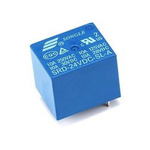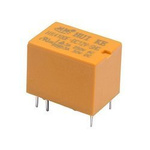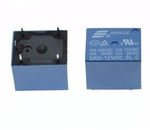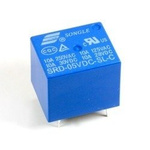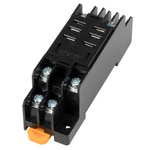Add products by adding codes
Electromagnetic Relays
( quantity of products: 18 )Electromagnetic relays are an integral part of many electronic devices.
The basic types of electromagnetic relays are monostable relays,bistable i astable. Each has its own unique characteristics and applications that determine their choice for specific situations.
Monostable relays, also known as pulse relays, are most commonly used in devices that require a single pulse to switch state.
In this category you will find 5V relays, 12V relays,24V as well as 230V
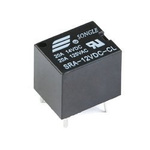
SONGLE SRA-5VDC-CL 20A - 5V - 5PIN T74 power relay - 14VDC 125VAC contacts
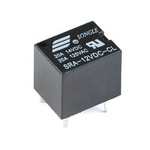
SONGLE SRA-24VDC-CL 20A - 24V - 5PIN T74 power relay - 14VDC 125VAC contacts
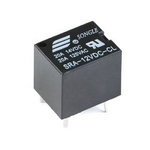
SONGLE SRA-12VDC-CL 20A - 12V - 5PIN T74 power relay - 14VDC 125VAC contacts
1. Principle of Operation of Electromagnetic Relays
Electromagnetic relays are extremely important components in many systems and devices. They work on the principle of electromagnetic induction, meaning that the flow of current through the coil creates a magnetic field, which in turn affects the movement of the mechanical component. It is this movement that is used to open or close electrical circuits.
Electromagnetic relays have many advantages. Above all, they are extremely reliable and can operate for long periods of time without maintenance or repair. In addition, because of their simplicity, they are relatively inexpensive to produce and easy to install. Nevertheless, they also have their drawbacks. First of all, due to their mechanical nature, they are susceptible to physical damage. In addition, they can be inefficient in systems that require fast switching.
In summary, electromagnetic relays are extremely important components in many systems. Due to their reliability and simplicity, they are often chosen by designers and engineers. However, their mechanical nature can be a problem in some applications, especially where fast switching is required.
2. Application of Electromagnetic Relays in Practice
Electromagnetic relays are an indispensable part of many systems and devices. Their versatile use is due to their unique properties, such as the ability to switch circuits under the influence of a change in the magnetic field. In practice, electromagnetic relays are often used in alarm systems, telecommunications equipment, as well as in industrial automation.
In industrial automation, electromagnetic relays play a key role. Enable control of heavy loads using small control voltages. As a result, it is possible to safely and efficiently control high-powered equipment. Here are some examples of electromagnetic relay applications in practice:
- Alarm systems - electromagnetic relays are used to activate alarm sirens when the system detects a threat.
- Telecommunications equipment - in telephone exchanges, electromagnetic relays are used to switch calls.
- Industrial automation - electromagnetic relays allow control of high-powered devices such as motors or heaters.
In summary, electromagnetic relays are an extremely important component of many systems and devices. Their versatile use makes them indispensable in many fields, from alarm systems, to telecommunications, to industrial automation.
3. Comparison of Electromagnetic Relays with Other Types of Relays
Analyzing the different types of relays, electromagnetic relays stand out for their reliability and efficiency. Compared to other types, such as solid-state relays or thermal relays, they offer a number of advantages. Their main feature is the ability to transmit high currents without generating heat, which translates into long life and trouble-free operation. Electromagnetic relays are also more resistant to interference, making them an ideal choice in environments with high levels of electromagnetic noise. Nevertheless, they are not without flaws. Their main limitation is the need to power the coil, which can be problematic in low-voltage systems. Nevertheless, for many applications, electromagnetic relays are still the most suitable choice.
4. Key Parameters of Electromagnetic Relays
Rated voltage is one of the key parameters of electromagnetic relays. It determines the maximum voltage that the relay is able to conduct safely. If this voltage is exceeded, the relay may be damaged or even cause a fire. Therefore, always pay attention to this parameter when selecting a relay for a specific application.
The second important parameter is rated current. This is the maximum current that the relay is able to conduct. The rated current depends on the material of the relay contacts and their design. Among the most important parameters of electromagnetic relays are:
- Rated voltage
- Rated current
- Coil resistance
- Operating temperature
- Response time
Finally, it is worth mentioning response time. This is the time that elapses from the moment the voltage is applied to the coil of the relay until the contacts close. Response time is particularly important in applications where speed of response is crucial, such as in alarm systems or motor controls.
5. How to Choose the Right Electromagnetic Relay?
Choosing the right electromagnetic relay is not a simple task. It is important to pay attention to several key aspects. The first step should be to understand the technical specifications of the device to which the relay is to be connected. The second step is to determine the performance requirements of the relay, such as response time, rated voltage or rated current.
- Understand the technical specifications of the device: The electromagnetic relay must be compatible with the device to which it is to be connected. To do this, it is necessary to know such parameters as supply voltage, rated current or type of load.
- Determine relay performance requirements: When choosing a relay, it is worth paying attention to such parameters as response time, rated voltage or rated current. These parameters directly affect the performance and reliability of the relay.
Frequently Asked Questions
Are electromagnetic relays durable?
Electromagnetic relays are usually very durable and can operate for many years without replacement, provided they are properly maintained and not overloaded.Are electromagnetic relays safe to use?
Yes, electromagnetic relays are safe to use, provided they are properly installed and maintained. Always follow safety rules when working with electrical equipment.Are electromagnetic relays energy efficient?
Electromagnetic relays tend to be more energy efficient than other types of relays because they use magnetic energy to switch circuits, instead of direct current flow.What are the most common applications of electromagnetic relays?
Electromagnetic relays are widely used in a wide variety of applications, including alarm systems, control systems, telecommunications equipment and many others.Are electromagnetic relays easy to install?
Yes, electromagnetic relays are usually easy to install, but it is always recommended to use a professional electrician to ensure proper installation and safety.


